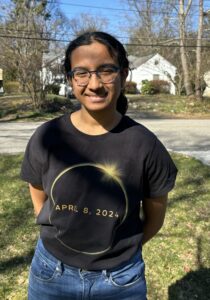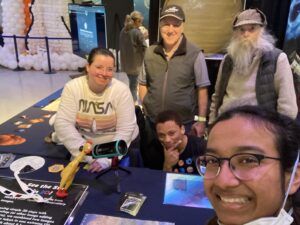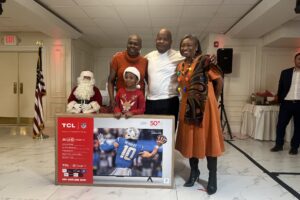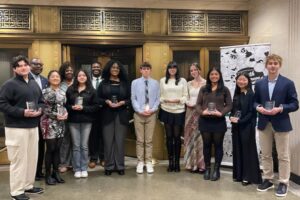
Astronomy took root early in my life; my nursery walls were covered with glow-in-the-dark stars, and at around six I played for hours with my imaginary sister Moday from Venus.
When I was a little older, I remember sitting in my room on sunny days watching with fascination the splash of colors on the wall as I turned a prism over and over in my hands. Little did I realize that when I innocently made those rainbows, I was experiencing the basis of spectroscopy.
This childish interest was followed by a period of deep interest in science books such as A Brief History of Time by Stephen Hawking to Physics of the Impossible by Michio Kaku and numerous annual visits to the National Air and Space Museum in Washington, D.C. These childhood experiences started becoming more concrete when last summer, I decided to take a pre-college course in astronomy at Brown University. Terms such as special and general relativity, HR diagrams, black holes, nebulae, and exoplanets became so much more meaningful, helping me create a mental model of the dynamic nature of space.
The amazing experience at Brown led me to start an astronomy club at the start of 10th grade. I wanted to share my new passion with my peers in high school. The club activities include trivia, artwork, experiments, and ever fascinating space documentaries. We have hosted speakers from local universities and amateur astronomy associations on the basics of astronomy. Teachers from other grades have approached our club to do space-based activities with their class to create excitement about the cosmos.
Space exploration is no longer being pursued simply to satiate human curiosity but to explore opportunities for human habitation, commercial purposes, and national security. I am contributing to this endeavor by pursuing a three-year science research project with a Junior Fellow at Columbia University trying to analyze the parameters of various compact-merger-generating algorithms to test which one is the most accurate and why.

I am also a member of Westchester Amateur Astronomers and Amateur Astronomers Association. I join fellow members in stargazing sessions, learning about topics ranging from space telescopes and space photography to problems of debris and light pollution in space, to cryovolcanoes on various moons. As a member of AAA, I recently volunteered in the space section during Kids Week at The Intrepid; an educational outreach event geared at creating enthusiasm amongst the youth about science. I learnt about the seamstresses at NASA, black women in space to Mars rovers, James Webb Space Telescope, and next generation habitation systems. I even got a sneak peek into the Nancy Grace Roman Space Telescope, the next big space telescope to be launched after Webb. Scheduled to launch in 2027, it aims to estimate the number of habitable exoplanets.
The April 8 total solar eclipse promises a dazzling duet of the sun and moon. As per NASA, the total solar eclipse will cross North America, passing through Texas and ending in Maine. This eclipse will be the last of its kind that will be visible for people in the U.S. until 2045. Westchester is expected to see the eclipse in the afternoon hours, peaking at 3:26 p.m. (91% coverage). For more information on how to prepare and obtain free watching glasses, visit your larger local libraries.
The sky is not the limit!
Meera Desawale is a sophomore at Briarcliff High School. She is a space enthusiast and aims to share her passion with the community at large.







